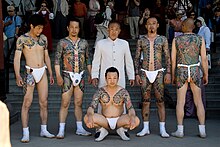Irezumi
All forms of irezumi are applied by hand, using wooden handles and metal needles attached via silk thread.
Two characters in the 1972 film Hanzo the Razor, set in the Edo period, are depicted with ring tattoos on their left arms as punishment for theft and kidnapping.
Tattooing for spiritual and decorative purposes in Japan is thought to extend back to at least the Jōmon or paleolithic period (approximately 10,000 BC) on the Japanese archipelago.
Some scholars have suggested that the distinctive cord-marked patterns observed on the faces and bodies of figures dated to that period represent tattoos, but this claim is not unanimously accepted.
[citation needed] Instead of being used for ritual or status purposes, tattoo marks began to be placed on criminals as a punishment.
[citation needed] Women were tattooed on the hands, forearms, and mouths in indigo to signify moving into adulthood, to protect against disease, and for aesthetic purposes.
It was in the Edo period however, that Japanese decorative tattooing began to develop into the advanced art form it is known as today.
Suikoden, a tale of rebel courage and manly bravery, was illustrated with lavish woodblock prints showing men in heroic scenes, their bodies decorated with dragons and other mythical beasts, flowers, ferocious tigers[5] and religious images.
Others claim that wealthy merchants, barred by law from flaunting their wealth, wore expensive irezumi under their clothes.
[citation needed] Following the opening of Japan's borders to the rest of the world at the beginning of the Meiji period, the Japanese government, conscious to protect its image and make a good first impression in the face of its new international status, outlawed tattooing, with irezumi soon taking on connotations of criminality.
[7] In 2020, the Supreme Court of Japan ruled that tattoos could be performed by people other than licensed medical professionals, a requirement still present in South Korea, after the home studio of an Osaka-based tattoo artist, Taiki Masuda, was raided by the police and the artist was fined.
As a result, the Japan Tattooist Organization formed and created a hygiene and safety online course for artists that provides a certificate of completion, similar to practices in other countries.
[10]: 185-186 This survey, along with other tattoo-related policies implemented by Hashimoto, was eventually found to have violated the city's privacy protection ordinance by the Osaka District Court.
Japanese artists are widely recognised for the quality of their work, despite the relative expense of irezumi tattoos, and are highly sought-after.
A typical traditional body suit, covering the arms, back, thighs and chest, with a space left down the centre of the torso, can take up to five years of weekly visits to complete, and cost in excess of US$30,000.
After an initial consultation during which the client will discuss with the tattooist the designs they are interested in, the work begins with the tattooing of the outline.





